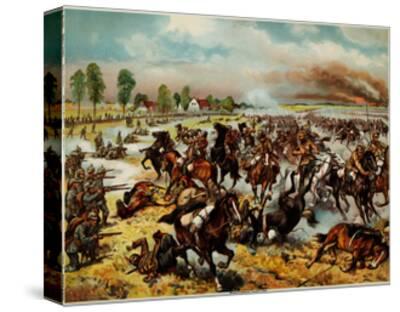

General Prittwitz was born in 1848, and later served as the commander of the German Eighth Army. His career ended in 1917 after the February Revolution when he was imprisoned for embezzlement and mismanagement. His lack of communication with the General Samsonov’s Second Army during the Battle of Tannenberg led to a decisive loss. After being in command of the Russian First Army, he invaded East Prussia by advancing northeast. He served and fought in the Imperial Russian Army for over 40 years, and was a big part of the Russo-Japanese War. General Rennenkampf was also a Russian general and born in 1854.

The General and his army fought well at the beginning parts of the battle until the Germans surrounded Samsonov between Allenstein and Willenberg. He obtained command of the Second Army in the invasion of East Prussia. General Aleksandr Vassilievich Samsonov was born in 1859 and a well-known general of the Imperial Russian Army. With the Germany Army garrisoned in Prussia, the only thing the Eighth Army had to do was hold back any attacks until the War on other fronts was decided.

Battle of tannenberg 1914 full#
With Germany occupying Prussia, they had access and full control of the railways deep in Russian territory. Russia suffered a major blow with this loss, and it blew a hole in their strategy. By using the railways effectively, the Russian Army could take out the Germans in a pincer formation. The railway in Prussia could only go as far as the German border using railways, but had a major strategical advantage. It’s also important to note that the Russians were reliant on the railways to transport their armies, with one of the two main ones being in Prussia.

East Prussia was considered a major vulnerability in Russian territory. In the early beginnings of World War I, positioning was everything. This sealed the deal for the German Army, as the battle was theirs to lose at this point. The Germans set a trap for the Russian army, and was also helped by the wireless intercepts of two major intelligence transmissions between Rennenkampf and Samsonov. The order was put in place but had not yet been executed, so when new commander Paul von Hindenburg organized a new attack, they did so with confidence due to the plan put in place by Colonel Maximilian Hoffman, Prittwitz’s deputy Chief of Operations. His retreat immediately reached Helmuth von Moltke the Younger, who dismissed him and put in place more aggressive leaders on the field. General Pritwitz had already been previously defeated by General Rennenkampf at the Battle of Gumbinnen, and was a bit wary of facing another defeat against an even larger oncoming force. An attack in both the front and rear would have been devastating to the Eighth Army, which was considered to be outmanned 4-1. By surrounding the much smaller German Eighth Army controlled by General Prittwitz, they could get a decided advantage in the entire area. The two-pronged attack by General Samsonov and General Rennenkampf included a southwest and northeast attack with the First and Second Army. The invasion was still in the beginning stages and hadn’t really got off the ground, and proved to be one of many failed efforts due to poor planning on Russia’s side. The Russians had lost 125,000 men, ten times the German losses.Battle of Tannenberg Russia Backstory Russia suffered a major loss in the Battle of Tannenberg, losing control of its Second Army on August 1914 due to clever planning by German soldiers. On the third day (29 August), the I Corp completed the encirclement of the Russian army, after which Samsonov was never heard from again, and his army disintegrated. The German XCII and I Reserve Corps pushed back the Russian right, the I Corps their left, and the XX Corps attacked their centre. Unbelievably, the Russians were using uncoded radio transmissions, and by this point the Germans knew exactly where the Russian troops were. On 24 August the Russian advance was halted at the battle of Orlau-Frankenau by the German XX Corps, which then withdrew to Tannenberg.
Battle of tannenberg 1914 series#
After a series of minor defeats against the Russians, the Germans placed General Paul von Hindenburg in command of the eastern front, with General Erich Ludendorff as his chief of staff, and on 22 August, before leaving for the east, Ludendorff put in place a plan to attack the Russian Second Army under General Alexander Samsonov, ignoring for the moment the Russian First Army. Battle of the First World War a crushing German victory over the Russians invading East Prussia.


 0 kommentar(er)
0 kommentar(er)
